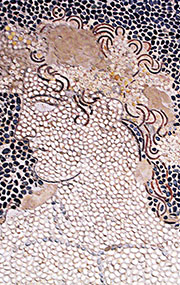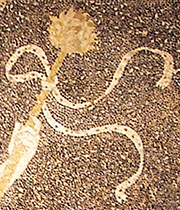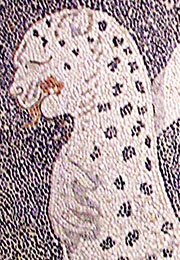Continued from gallery page 9
Dionysos (Διόνυσος), the Greek god of grape harvests, wine, revelry and ecstasy, is here pictured naked, youthful, athletic and relaxed, riding side-saddle - as if enthroned - on a large rearing or leaping panther (or leopard). His crown of ivy leaves, presumably rendered in gold, grapes of green-coloured ceramic beads and his eye of precious stone have been lost. With his right hand he holds onto the big cat's neck, while in his left he carries one of his symbols, the thyrsos (or thyrsus, Greek θύρσος), a staff of giant fennel (Ferula communis), tied with a taenia (Greek ταινία, flat band or ribbon, a ceremonial head-binding associated with sacred festivals), and topped by a large pine cone.
See more photos and information about Dionysus with a panther on the Dionysus page of the MFP People section.
The mosaic consists of small black and white pebbles, with grey stones for subtle shadows and red for the panther's mouth and tongue. Strips of lead have been used for some contours (around the god's profile and eybrow) and thin terracotta ceramic swirls for detailing such as Dionysos' hair. The flat, graphic, almost monochrome treatment of the subjects against a black background is restrained, dignified and realistic.
The dark background isolates the two figures and directs the viewers eye around the dynamic composition of opposing diagonals and curves. The subjects appear to be flying through a night sky, rather like representations of a stellar constellation. The iridescent effect of light reflecting off the pebbles, difficult to capture in a photograph, further heightens the dynamism of the mosaic.
Only the panther's head disturbs the modern eye. It seems far too small, and completely unrealistic, more like a medieval heraldic illumination than a product of Hellenistic art. Compare it to the lion in the Lion Hunt mosaic on gallery page 12.
In the late Archaic and Classical periods (6-5th centuries BC) in the Greek world, many male gods, such as Zeus, Poseidon, Hermes and Dionysos, were depicted as mature men with full beards (see photos below right and on Athens Acropolis gallery page 36). This tradition, also common among the ancient civilizations of Asia and Mesopotamia, gave deities and kings gravitas and underlined their masculinity, strength and maturity.
During the 4th century BC and through the Hellenistic era (323-146 BC), following the conquests of the eternally young, wine-loving son of Pella, Alexander the Great, Dionysos lost years and his beard and gained suppleness. This was no doubt a result not only of changing attitudes to the god but also of the influence on art of portraits of the young Alexander and his successors, such as Lysimachos (360-281 BC) and Attalos I of Pergamon (269–197 BC).
Although never depicted as particularly virile or masculine (unlike his brother Hermes), by Roman times he was even being portayed as effeminate or helpless in a drunken stupor. Nevertheless, some Romans also had a taste for the traditional, archaic Dionysos, as existing copies of Archaic style Greek originals testify.
Further reading
Katherine M. D. Dunbabin, Mosaics of the Greek and Roman World. Cambridge University Press, 1999. Preview at googlebooks.
Zografia Welch, Mosaic pavements in Classical and Hellenistic dining rooms. MA thesis, McMaster University, 1992.
J. J. Politt, The art of ancient Greece: sources and documents. Cambridge University Press, 1990. |

Dionysos depicted as a
handsome, athletic youth. |
| |

A thyrsos, the staff
of Dioysos. |
| |

The head of the panther. |
|